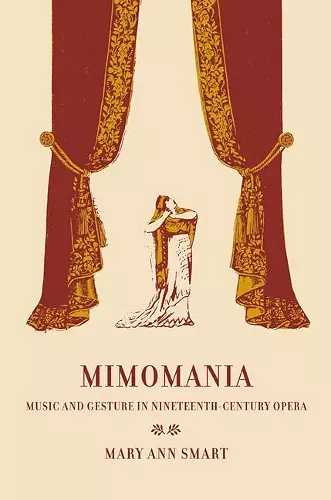Mimomania
Music and Gesture in Nineteenth-Century Opera
Format:Paperback
Publisher:University of California Press
Published:24th Feb '06
Should be back in stock very soon

When Nietzsche dubbed Richard Wagner 'the most enthusiastic mimomaniac' ever to exist, he was objecting to a hollowness he felt in the music, a crowding out of any true dramatic impulse by extravagant poses and constant nervous movements. Mary Ann Smart suspects that Nietzsche may have seen and heard more than he realized. In "Mimomania", she takes his accusation as an invitation to listen to Wagner's music - and that of several of his near-contemporaries - for the way it serves to intensify the visible and the enacted. As Smart demonstrates, this productive fusion of music and movement often arises when music forsakes the autonomy so prized by the Romantics to function mimetically, underlining the sighs of a Bellini heroine, for instance, or the authoritarian footsteps of a Verdi baritone. "Mimomania" tracks such effects through readings of operas by Auber, Bellini, Meyerbeer, Verdi, and Wagner. Listening for gestural music, we find resemblance in unexpected places: between the overwrought scenes of supplication in French melodrama of the 1820s and a cluster of late Verdi arias that end with the soprano falling to her knees, or between the mute heroine of Auber's "La Muette de Portici" and the solemn, almost theological pantomimic tableaux Wagner builds around characters such as Sieglinde or Kundry. "Mimomania" shows how attention to gesture suggests a new approach to the representation of gender in this repertoire, replacing aural analogies for voyeurism and objectification with a more specifically musical sense of how music can surround, propel, and animate the body on stage.
"A thoughtful, thought-provoking study of certain aspects of gestural music.... Bound to become a valuable reference source." - Ira Siff, Opera News "Mimomania is a thoughtful meditation on the persistence and transformation of the musical mimicry of bodily gesture in nineteenth-century opera. Incorporating and reacting to feminist critique, film studies, and recent, new-wave opera studies, Smart shows that this ostensibly straightforward relation of music and action hides unexpected complexities. From these the rethinks important works from the period and indeed the relation of its two giants, Verdi and Wagner." - Gary Tomlinson, author of Metaphysical Song: An Essay on Opera "Mary Ann Smart's important and timely book documents - deftly and in rich musical detail - the ways that nineteenth-century operas reflect a character's emotive state in the music and in sometimes closely coordinated physical gestures. Opera lovers will delight in applying Smart's insights to yet other works: ones that they know, love, and sometimes puzzle over." - Ralph P. Locke, Professor of Musicology, Eastman School of Music"
ISBN: 9780520248311
Dimensions: 229mm x 152mm x 18mm
Weight: 363g
254 pages